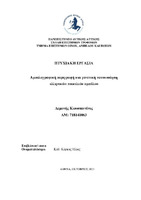| dc.contributor.advisor | Κόρκας, Ηλίας | |
| dc.contributor.author | Λεμονής, Κωνσταντίνος | |
| dc.date.accessioned | 2024-07-22T08:04:00Z | |
| dc.date.available | 2024-07-22T08:04:00Z | |
| dc.date.issued | 2023-10-05 | |
| dc.identifier.uri | https://polynoe.lib.uniwa.gr/xmlui/handle/11400/7127 | |
| dc.identifier.uri | http://dx.doi.org/10.26265/polynoe-6961 | |
| dc.description.abstract | Κατά την καλλιεργητική περίοδο του έτους 2022 μελετήθηκαν οχτώ (8) ελληνικές
ποικιλίες αμπέλου από τη Σκύρο (Σποράδες). Για την μελέτη τους συλλέχθηκαν δείγματα
νεαρών κορυφών με τα νεαρά τους φύλλα, ώριμα ανεπτυγμένα φύλλα και σταφύλια από δύο
περιοχές της Σκύρου (Τραχύ και Ασπούς). Σκοπός της εργασίας ήταν η αμπελογραφική
περιγραφή και η γενετική ταυτοποίηση των ποικιλιών αμπέλου: Μαερνό, Μαυραγάνι,
Μαυραυγουστιάτης, Άσπρο, Χατζήδικο, Αγιαναστασάς, Σεριφιώτικο και Τραγανό.
Η αμπελογραφική περιγραφή έγινε βάση συγκεκριμένων περιγραφέων του Διεθνούς
Οργανισμού Οίνου και Αμπέλου (OIV) και αφορούσαν: 1) την κορυφή του νεαρού βλαστού,
2) το νεαρό φύλλο, 3) το πλήρως ανεπτυγμένο φύλλο, 4) τη σταφυλή και 5) τη ράγα.
Η μοριακοί ταυτοποίηση πραγματοποιήθηκε με μικροδορυφόρους SSR (Simple
Sequence Repeats) και τριχοειδή ηλεκτροφόρηση. Στην μοριακή ταυτοποίηση τα δείγματα 1,
2, 4, 5 και 6 της ποικιλίας «Μαερνό» έδειξαν τα πιο ενθαρρυντικά αποτελέσματα στη μελέτη
τους καθώς υπάρχει ομαδοποίηση μεταξύ τους, κάτι που δεν παρουσιάστηκε σε κάποια άλλη
ελληνική ποικιλία με παρόμοια ακολουθία σύμφωνα με τα δεδομένα του ΕΛΓΟ -
ΔΗΜΗΤΡΑ. Στο δείγμα #7 «Μαυραυγουστιάτη» υπήρξε μία ισχυρή ομοιότητα με την
ποικιλία «Μανδηλαριά». Κατά την αμπελογραφική περιγραφή σημαντικό σημείο αποτέλεσε
η ομοιότητα μεταξύ των δειγμάτων 1, 2, 3, 5 και 6 της ποικιλίας «Μαερνό» όπως ήταν
αναμενόμενο. | el |
| dc.format.extent | 58 | el |
| dc.language.iso | el | el |
| dc.publisher | Πανεπιστήμιο Δυτικής Αττικής | el |
| dc.rights | Αναφορά Δημιουργού - Μη Εμπορική Χρήση - Παρόμοια Διανομή 4.0 Διεθνές | * |
| dc.rights | Attribution-NonCommercial-NoDerivatives 4.0 Διεθνές | * |
| dc.rights.uri | http://creativecommons.org/licenses/by-nc-nd/4.0/ | * |
| dc.subject | Ελληνικές ποικιλίες αμπέλου | el |
| dc.subject | Αμπελογραφική περιγραφή | el |
| dc.subject | Μοριακή ταυτοποίηση | el |
| dc.subject | Μικροδορυφόροι SSR | el |
| dc.subject | Αλυσιδωτή αντίδραση πολυμεράσης | el |
| dc.subject | Τριχοειδής ηλεκτροφόρηση | el |
| dc.title | Αμπελογραφική περιγραφή και γενετική ταυτοποίηση ελληνικών ποικιλιών αμπέλου | el |
| dc.title.alternative | Ampelographic description and genetic identification of Greek grapevine varieties | el |
| dc.type | Πτυχιακή εργασία | el |
| dc.contributor.committee | Μερκουρόπουλος, Γεώργιος | |
| dc.contributor.committee | Taskos, Dimitrios | |
| dc.contributor.faculty | Σχολή Επιστημών Τροφίμων | el |
| dc.contributor.department | Τμήμα Επιστημών Οίνου, Αμπέλου και Ποτών | el |
| dc.description.abstracttranslated | During the cultivation period of the year 2022, eight (8) Greek grapevine varieties from
Skiros (Sporades) were studied. Samples were collected from young shoots with their young
leaves, fully developed leaves, and grapes from two regions of Skiros (Trachy and Aspous).
The purpose of the study was the ampelographic description and genetic identification of the
grape varieties: Maerno, Mavragani, Mavraugoustiatis, Aspro, Chatzidiko, Agianastasis,
Serifiotiko, and Tragano.
The ampelographic description was based on specific descriptors from the International
Organization of Vine and Wine (OIV) and covered: 1) the tip of the young shoot, 2) the
young leaf, 3) the fully developed leaf, 4) the grape, and 5) the cane.
Molecular identification was performed using microsatellite SSR (Simple Sequence
Repeats) markers and capillary electrophoresis. In the molecular identification, samples 1, 2,
4, 5, and 6 of the “Maerno” variety showed the most encouraging results in their study, as
they clustered together, something that did not occur in any other Greek variety with a similar
sequence according to the data from ELGO - DIMITRA. Sample #7, “Mavraugoustiatis”
exhibited a strong similarity to the variety “Mandilari”. During the ampelographic
description, an important point was the similarity between the samples 1, 2, 3, 5, and 6 of the
“Maerno” variety as it was expected. | el |


